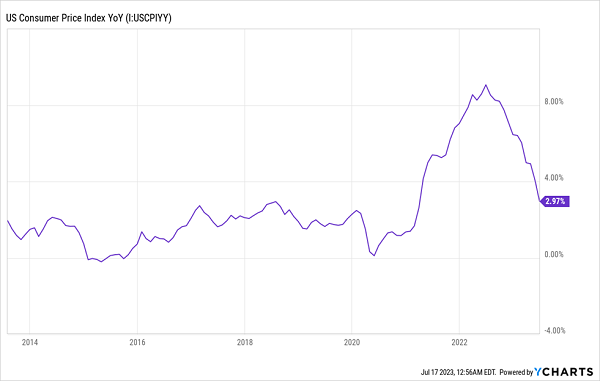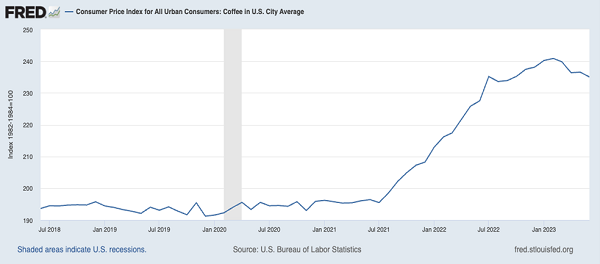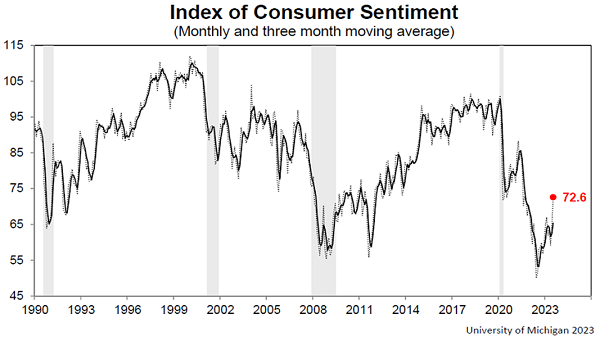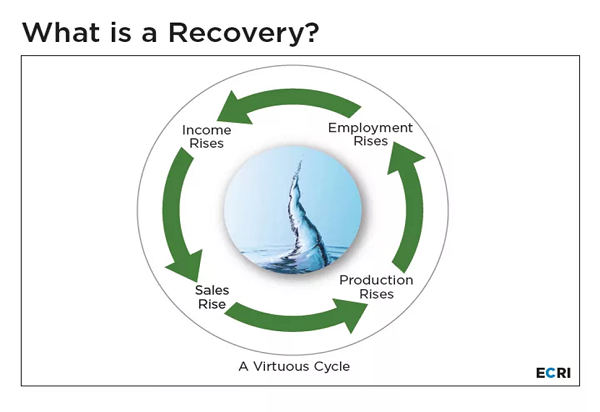I recently read a couple news pieces that brought what’s happening in the US economy these days into sharp focus. It’s a phenomenon I like to call “Cappuccino Effect.”
I’ll admit, it sounds too cute by half. But stick with me as we run through it, because I think it highlights a timely buying opportunity in 7%+ yielding equity closed-end funds (CEFs) whose portfolios are tilted toward consumer names.
Let’s start with inflation, which we all know ran hot last year. Some people didn’t expect this, while others thought it would last for a long time. Turns out both were wrong.
Inflation Rolls Over

You still read some news stories hyping the fact that inflation is 3% instead of the Fed’s 2% target, but that argument is getting harder to make, especially since the actual number is 2.97%, so we’ve already got a two-handle. Plus, despite humanity’s love of complaining, more people are noticing prices starting to fall on some things.
First it was milk, a surplus of which in Wisconsin prompted farmers to dump thousands of gallons into sewers. Milk prices have plummeted, and milk products are down 1.5% from their peak in February:
Milk Hits the Ceiling

Cynics will scoff at a small decline in dairy prices, but it’s important: as a staple and a food item, dairy is the kind of thing whose price either stays relatively stable or slowly rises. If restaurants and retailers feel like they can’t raise prices of cheeses and items with cheese in them, it means we’re not in an economy of uncontrolled price gains.
More important is what’s happening with coffee, because it’s a tradable global commodity whose prices reflect a mix of demand and market conditions; and with coffee consumption always rising, as well as climate change resulting in bad weather (coffee plants are very sensitive to temperature and humidity), we should expect prices to keep climbing. Especially if we’re in an inflationary economy.
Except they aren’t. Earlier this month, Bloomberg reported that a “fall in wholesale arabica bean prices [will] kick in after a lag,” explaining that wholesale-coffee prices have dropped, likely due to supply-chain issues being resolved. That will result in lower coffee-shop and supermarket coffee prices soon, even if we aren’t seeing those yet. And this isn’t me talking: it’s a report from the International Coffee Organization.
Coffee Prices Just Starting to Spill

Of course, prices are still far higher than they were before 2020: the world has changed, and prices are unlikely to reverse. But they are unlikely to surge higher, and that’s important for one reason: spending.
In July, the University of Michigan Consumer Sentiment index rose to 72.6, ahead of the 65.5 expected and the largest gain for the indicator since 2005.

Obviously, this is still a historically low level—lower than 2009! But every data point I’ve seen—such as GDP, income growth and productivity gains—is better now than it was then.
This is the beginning of the Cappuccino Effect: people are starting to see that they were overly pessimistic and, yes, they actually can afford that cappuccino, thank you very much. So they spend a little more, and Starbucks Corp. (SBUX) earns a little more revenue, and they spend more buying things from their vendors, who then spend more—you get the idea.

Source: Economic Cycle Research Institute
What does this have to do with CEFs? Mainly that being in the market now, while this cycle is still in early days, is a proven way to make money. And CEFs, of course, are our preferred vehicle here, as we’re getting most of our return through dividends, thanks to these funds’ 7%+ yields.
Something else interesting is going on now, too, with some equity CEFs—including the Liberty All-Star Growth Fund (ASG). The 7.8%-yielding fund has broadly gained with the recovery this year, while still trading at a discount to net asset value (NAV, or the value of their underlying portfolios).
ASG is nicely positioned to profit from growing consumer spending, as it holds retail (and retail-related) stocks like Microsoft (MSFT), Amazon.com (AMZN) and Visa (V).
Right now, the fund yields 7.8% and trades at a 3.3% discount to NAV. That doesn’t sound like much of a deal, but it’s below the 1.2% premium the fund has averaged over the last five years. That shows we still have some upside here, even though the fund’s market price has gained 22% since January 1. Moreover, the fund’s NAV gains (up 18% this year) point to continued strong dividends as it sells holdings at a profit and hands us the cash).
ASG is one of many equity CEFs that should benefit as the cycle of higher sales, production, employment and income picks up. That cycle is still in its early stages, and most people haven’t realized it’s happening. But they will when they order a cappuccino and notice, hey, wait a second, paying for this isn’t painful like it was a year ago. That’s how boom times begin.
5 More “Cappuccino Effect” CEFs That Pay Dividends Monthly (and Yield 9.1%)
ASG is a great play at this stage of the rebound, but you don’t need to limit yourself to equity CEFs here. Truth is, there are plenty of buying opportunities in other CEFs, too, from corporate bonds to real estate investment trusts (REITs), municipal bonds and more.
In fact, now is the time to build a diversified CEF portfolio and “lock in” these funds’ high payouts at BIG discounts (before these deals disappear in the ongoing rebound).
To help you do just that, I’ve assembled a 5-CEF “mini-portfolio” that does three critical things:
- Pays high dividends, with an average yield of 9.1%.
- Pays dividends monthly (no more waiting a full quarter for your next check).
- Trades at outrageous discounts, setting the stage for 20%+ price gains in short order.
